
Each January, The Centers for Disease Control and Prevention and the Wisconsin Department of Health Services celebrate Radon Action Month to help people understand what radon is, its risk to health, how to test for it, and how to fix it.
Radon is an odorless gas that naturally occurs in the ground underneath homes, schools, and other buildings. Exposure to radon is the leading cause of lung cancer among people who have never smoked, and the second-leading cause of lung cancer overall.
Winter is the perfect time to test your home for radon. The Environmental Protection Agency recommends installing a radon mitigation system when a test result is at or above 4 picocuries per liter (pCi/L).
Visit the Wisconsin Radon Program’s website for more information.
Explore these resources to learn more about radon in Wisconsin:
| Webinar: National and State-Level Radon Risk Reduction Initiatives Hear from radon experts, including Wisconsin Department of Health’s Indoor Air and Radon Program Manager, Jess Maloney, as they discuss radon strategies and initiatives. Register Here |
| National Environmental Public Health Tracking Network Explore new county level radon testing data including rates pre and post mitigation at the CDC’s National Environmental Public Health Tracking Network. Explore the Data |
| Wisconsin Interactive Radon Map Wisconsin Interactive Radon Map provides information to help determine the risk of indoor radon levels at the zip code level. View Map |
| Radon 101 Video This short video and this webinar share information on how to protect your home from radon. Watch the Video Watch the Webinar |
| Wisconsin Radon Action Month Awareness Toolkit Wisconsin Radon Action Month Toolkit provides Wisconsin specific information to promote radon awareness during January. View the Toolkit |
